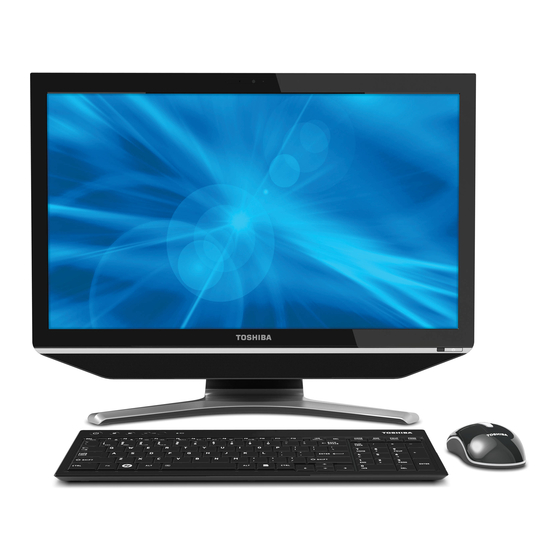
Table of Contents
Advertisement
Quick Links
Advertisement
Table of Contents

Summarization of Contents
Preface
Conventions
Explains formatting and terminology used in the manual.
Abbreviations
Lists and defines abbreviations used throughout the manual.
Icons
Keys
Describes how keyboard keys are represented in the manual.
Key operation
Explains how to perform key combinations and special key operations.
General Precautions
Provide adequate ventilation
Instructions on ensuring proper airflow to prevent overheating.
Creating a computer-friendly environment
Guidelines for setting up a safe and optimal workspace for the computer.
Chapter 1 Getting Started
Equipment checklist
Lists all hardware, documentation, and software included with the computer.
Chapter 2 The Grand Tour
Computer
Identifies and describes the computer's front side components.
Wireless Keyboard
Power button (computer)
Describes the keyboard's power button for the computer.
Remote Controller
Power
Explains the power button on the remote controller and its relation to computer power states.
Internal Hardware Components
CPU
Explains the CPU and how to check its specifications.
Chapter 3 Operating Basics
Touch Screen
Explains how to use the touch screen with various gestures.
The Keyboard
Keyboard indicators
Explains how the computer indicates keyboard status (Num Lock, Caps Lock, Scroll Lock).
3D Function
Important Safety Information for 3D Function
Crucial safety warnings related to viewing 3D content.
3D Playback on an External 3D Device
Requirements for displaying 3D content on external devices.
Wireless communications
Wireless LAN
Details the compatibility and standards for Wireless LAN.
LAN
LAN cable types
Specifies the types of LAN cables required for different network speeds.
Optional devices
Memory media slot
Details the memory media slot and supported card types.
Additional memory module
Installing a memory module
Detailed procedure for installing a memory module, including safety precautions.
TV Tuner
Connecting the coaxial cable
Instructions for connecting the coaxial cable to the TV tuner jack.
HDMI Out
Connecting the HDMI out port
Step-by-step instructions for connecting an HDMI cable.
Security lock
Connecting the security lock
Instructions for attaching a security cable.
Sound System
Volume Mixer
How to use the Volume Mixer to adjust audio levels for devices and applications.
Microphone Level
Steps to adjust the microphone recording level.
Dolby Advanced Audio
Details the features of Dolby Advanced Audio for enhanced sound.
Computer Handling
Cleaning the computer
Instructions on how to clean the computer's exterior and display.
Chapter 4 Utilities & Advanced Usage
Utilities and Applications
Lists and describes pre-installed utilities and how to start them.
Using the TOSHIBA Face Recognition
How to register the Face Recognition Data
Step-by-step process for registering facial data for login.
TOSHIBA Password Utility
User Password
How to register and set a user password for computer startup.
HW Setup
Accessing HW Setup
Steps to launch the HW Setup program.
HW Setup window
Overview of the HW Setup window, its tabs, and buttons.
General
Information about BIOS/EC versions and factory settings.
Password
Section for setting or resetting the power-on password.
LAN
Wake-up on LAN
Information on Wake-up on LAN functionality.
TOSHIBA PC Health Monitor
Starting the TOSHIBA PC Health Monitor
Methods to start and enable the PC Health Monitor.
System Recovery
System Recovery Options
Details on repairing startup problems, running diagnostics, and restoring the system.
Creating Recovery Media
Step-by-step guide to creating recovery media (disc or USB).
Chapter 5 Power and Power-Up Modes
Monitoring of power condition
How the Power indicator alerts users to the computer's operating status.
Power indicator
Details the meaning of different Power indicator light states.
Battery
Information about the computer's battery, including the RTC battery.
Chapter 6 Troubleshooting
Problem solving process
Guidelines for effectively diagnosing and solving problems.
Preliminary checklist
Simple checks to perform before diagnosing more complex issues.
Analyzing the problem
Software
Troubleshooting steps related to software or media issues.
Hardware and system checklist
Power
Troubleshooting power-related issues, including overheating and AC power.
Appendix A Specifications
Physical Dimensions
Provides the physical size and dimensions of the computer.
Environmental Requirements
Lists operating and non-operating environmental conditions.
Power Requirements
Details the AC adapter and computer power specifications.
Appendix C Legal Footnotes
Non-applicable Icons
Notes that not all features shown on the chassis may be present on the selected model.
CPU
Legal footnotes regarding CPU performance variations and automatic shutdown.
Appendix D Information for Wireless Devices
Wireless LAN Interoperability
Details Wireless LAN standards and compliance.
Bluetooth wireless technology Interoperability
Details Bluetooth standards and interoperability.
CAUTION about Wireless Devices
Important cautions regarding wireless device operation and potential interference.
Using this equipment in Japan
1. Important notice
Important notices regarding frequency bandwidth and potential interference in Japan.














Need help?
Do you have a question about the DX735 Series and is the answer not in the manual?
Questions and answers